White Rabbbit UNILAC PZ (wr-unipz)
Introduction
"wr-unipz" is a component of the MIL-based UNILAC 'Pulszentrale' (UNIPZ). As a field-bus, it does not use the MIL 'Event' bus but a White Rabbit network. Logically,
wr-unipz is identical and on the same level as the seven 'Pulszentralen' (PZ) of the UNILAC timing system. As for the other PZ, data supply and 50 Hz synchronization are provided through the 'Super Pulszentrale' (SPZ) of the UNILAC timing system. For technical and conceptual reasons, the UNILAC timing system and the GSI/FAIR General Machine Timing system (GMT) must use two distinct White Rabbit networks.
How-To
- WR-UNIPZ
- MIL-UNIPZ
- Users at UNILAC
- identical interface as for the FAIR timing system
- same timing receivers (SCU, Pexaria...)
- same drivers, Etherbone tools, saftlib
- differences
- timing messages have a 'UNILAC dialect', see here
- there are just UNILAC events and no such thing as CMD_SEQ_START ...
Documentation
Overview
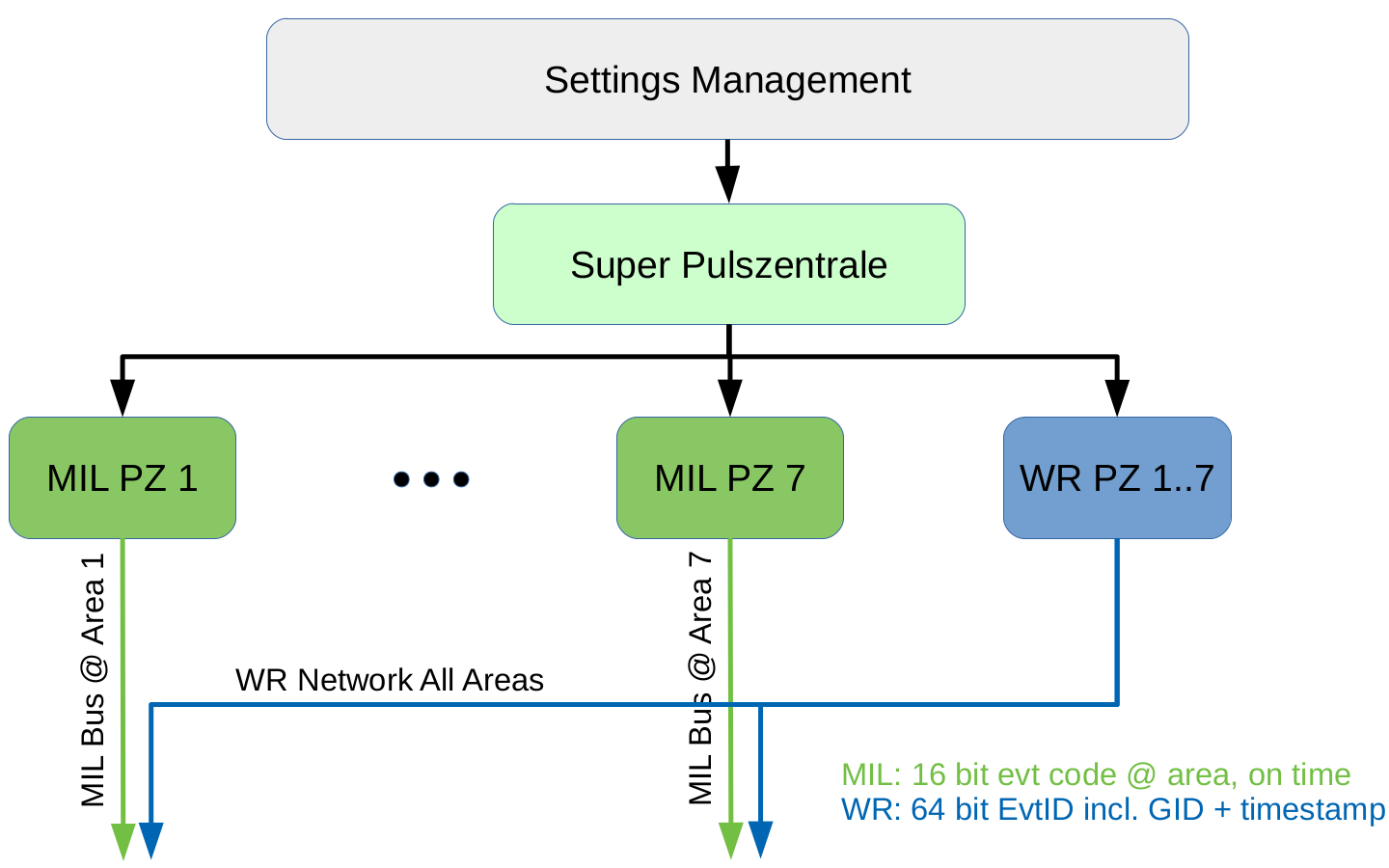 Figure:
Figure: Integration of White Rabbit Pulszentrale into UNILAC Pulszentrale. Shown are the existing components
Settings Management (grey box),
Super Pulszentrale (light green box), Pulszentralen 1..7 (green boxes) and the new
White Rabbit Pulszentrale (blue box). As well shown are
MIL event bus lines (green arrows), a
White Rabbit network (blue arrows) as well as connections from Super Pulszentrale to PZs (black arrows). Details see text.
Today (2020) the UNILAC is still operated using the 'old GSI control system'
Device Access . The timing system is based on a so-called
MIL Event Bus with a
Pulszentrale (PZ) as master. UNILAC has seven timing areas with one PZ each. Thus, there are seven distinct MIL cables, one for each PZ. The seven PZs are coordinated via the
Super Pulszentrale (SPZ), which has two tasks.
- It supplies the PZs with data. The data contain information for up to 16 independent virtual accelerators (VACC). For each VACC there are two distinct sets of data (called 'Kanäle'), one for normal operation and one for low intensity operation ('verkürzt', 'Profilgitterschutz'). In total the SPZ needs to provide 7 * 16 * 2 = 224 event sequences. Each sequence is a list of event data and a time offset relative to the beginning of a UNILAC cycle. SPZ transmits the data to the PZs using Device Access via the standard ACC network.
- SPZ and the PZs are interconnected via an internal MIL event bus. SPZ uses this internal bus for various purposes:
- announce event: announces the virtual accelerator number that must be played for a specific PZ during the next cycle; there may be up to seven of these events per cycle (one for each PZ)
- cycle start event: starts the next UNILAC cycle. Each cycle has a length of ~20ms (50 Hz); there is one event per cycle starting the event sequences at (up to) seven PZs simultaneously
- service event: service events are played after the event sequence (at a PZ) has been completed, there is one event for each service event to be sent
- synch data event: if new data have been supplied via Device Access, they will become active during the next cycle; this event is processed by all PZs
The
White Rabbit PZ just behaves like the seven PZ. It is supplied via Device Access and is connected to the internal MIL Event Bus to receive the events from SPZ. There are two main difference to the seven PZs.
- there is only one White Rabbit network for all seven timing areas at UNILAC
- White Rabbit PZ uses the concept of an alarm based timing system unlike the seven PZs, that are event based
UNIPZ
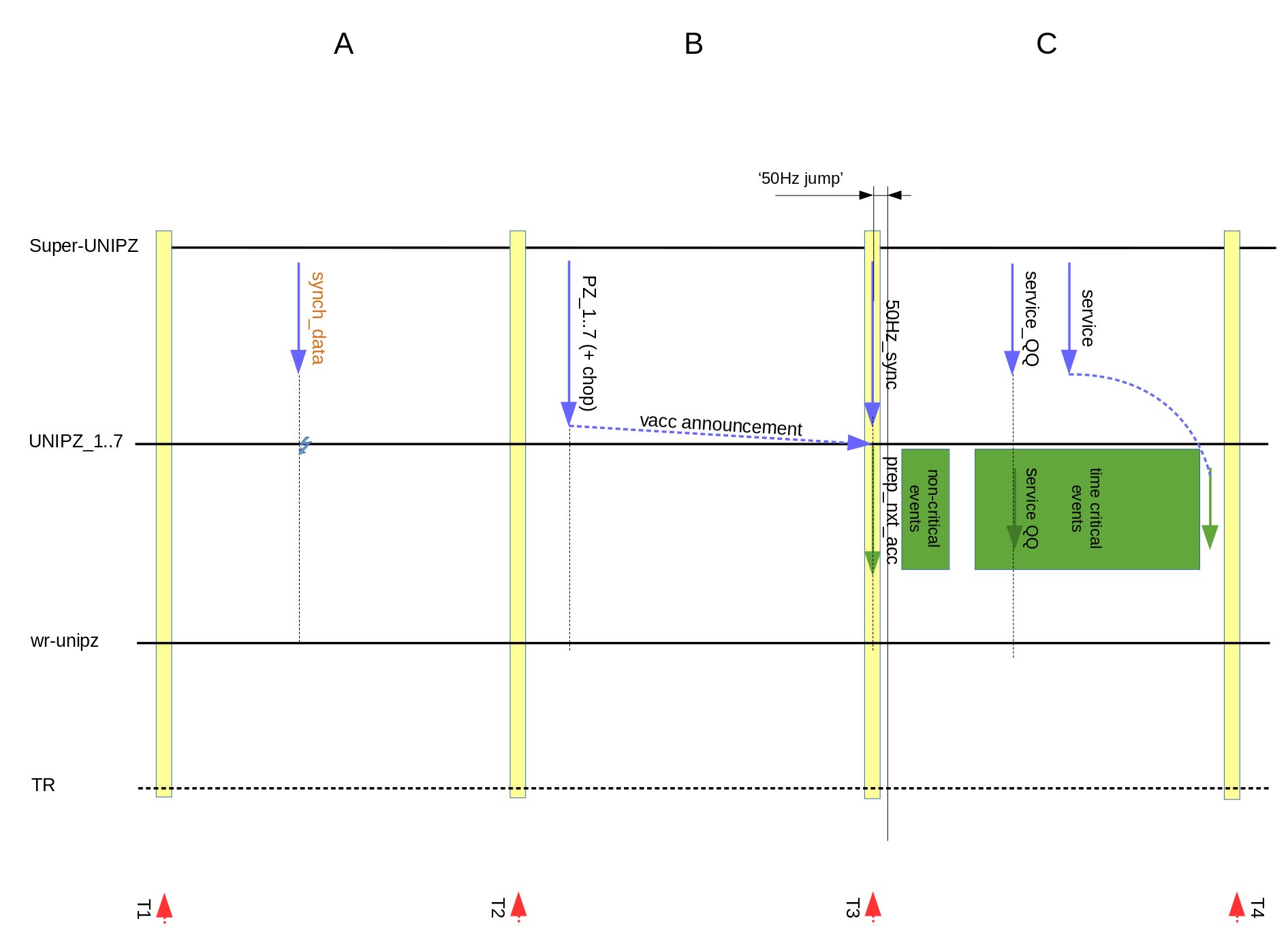 Figure:
Figure: Most simplified view on UNIPZ (upper part). It is a combination of a Super-UNIPZ and seven UNIPZ1..7. Shown are three UNILAC cycles A, B and C. Short red arrow: Beginning of a UNILAC cycle T1..T4. Blue arrows: MIL events from Super-UNIPZ. Green arrows and boxes: MIL events from UNIPZ1..7 to front-end computers. See text for more details.
The above figure shows a simple overview on UNIPZ. Each cycle has a length of approximately 20 ms (50 Hz). Cycles are synchronized to the 50 Hz mains frequency (not shown). A hardware logic follows the variation in the mains frequency slowly, thus UNILAC cycles may differ in length. In the figure above this is depicted as '50 Hz jump' (this will be important later).
UNIPZ consists of seven "Pulszentralen" PZ 1..7. Each is dedicated to a specific section in UNILAC and controls real-time activity in that section be sending so-called 'timing-events' over the 'MIL event bus'. The overall coordination of PZ 1..7 is controlled via the so-called 'Super PZ' (SPZ). For this, PZ 1..7 are connected to the SPZ via an internal MIL event bus and SPZ controls PZ 1..7 by sending events (over that internal bus).
PZ 1..7 get supplied with schedule data in a two-step process. First, schedule data is loaded 'offline' into shadow registers of PZ 1..7 (not shown). Second, schedule data in a shadow register is activated from SPZ by sending a 'synch_data' event to the relevant PZ.
Let's look at UNILAC cycle C in the above figure. As UNILAC supports up to 15 virtual accelerators and different settings for the beam chopper, this must be announced in the previous cycle B via an event 'PZ_1..7 (+ chop)' on the internal bus. Note, there is a separate event for each of the seven PZ 1..7. A UNILAC cycle is started, once SPZ sends a '50Hz_synch' event to the seven PZ 1..7; there is only one event for all PZs. This event is sent for each UNILAC cycle at a time indicated by short red arrows T1..4. Each of the seven PZ 1..7 immediately sends out an event 'prep_next_acc' to its section. Shortly after beginning of cycle C, the events are not time-critical and call for preparation of things happening in this cycle (left green box). Events later in the cycle are time-critical to about 1us (right green box).
While a cycle is running, SPZ may send 'service events' to one or more of PZ 1..7. Such service events will be played
after the schedule in a PZ has been played. An exception is a service event for the so-called QQ cavity, which must be sent out immediately. There is only
one service event per cycle and PZ (but I am not sure if a 'QQ service event' may be played additionally)
Concept of wr-unipz
The main conceptual problem is the following: What must be achieved is the transition from an event based to an alarm based system. But ...
An event based system triggers actions to happen
now, whereas an alarm based system schedules actions to be executed
in the future.
... this can't work out of the box.
At UNILAC however, the schedules are known prior to execution. Thus, a White-Rabbit-style Data Master is well suited, once it knows the schedule as the seven PZ 1..7 do,
if (!) the time is known when a UNILAC cycle starts. Unfortunately, this is not known beforehand, as the start of each cycle is triggered by the '50Hz_synch' of the SPZ on-time. The solution is shown in the following figure.
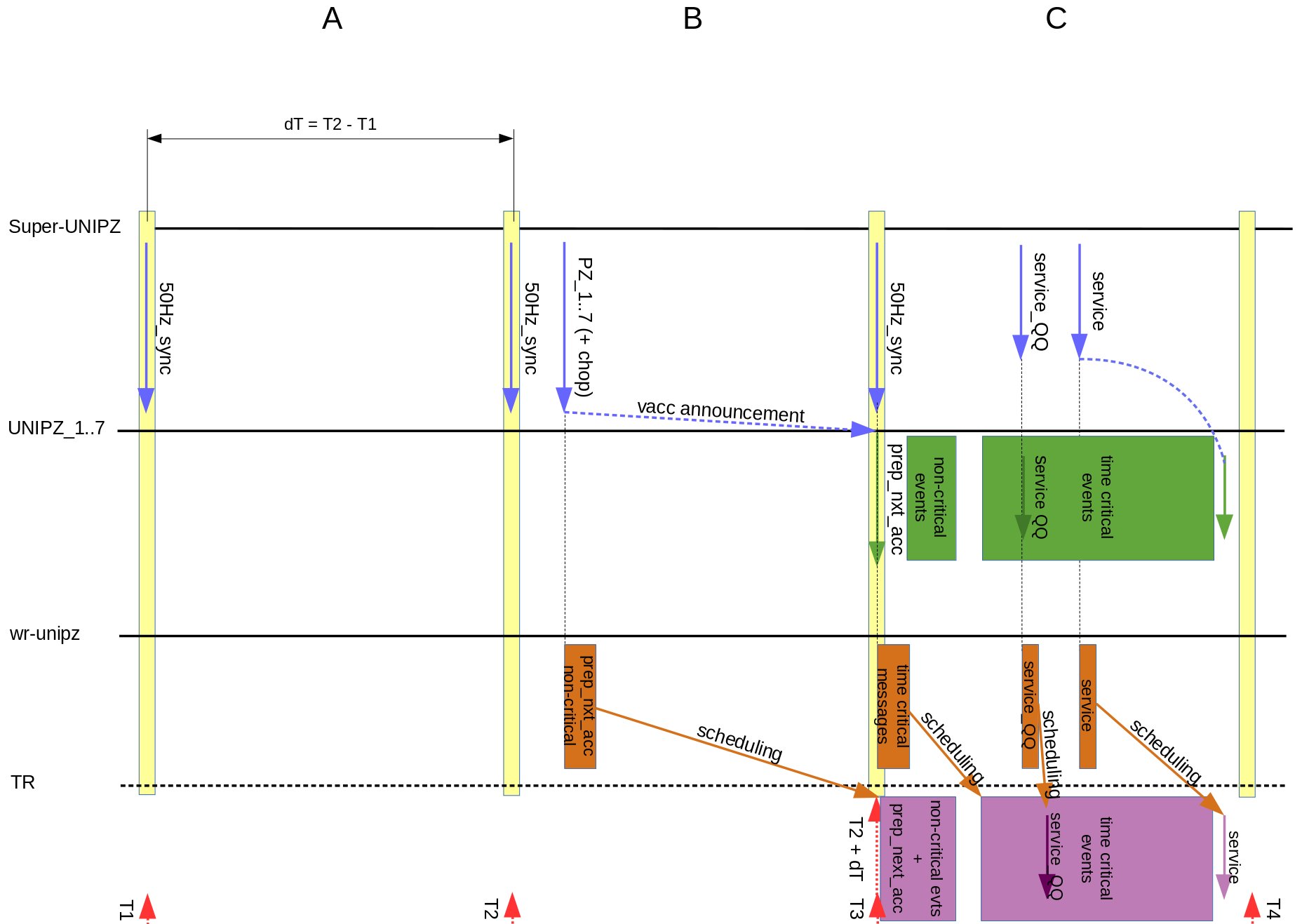 Figure:
Figure: Concept of wr-unipz (lower part). Dark orange boxes indicate when wr-unipz sends timing messages to the White Rabbit network. Dark orange arrows indicate how far in the future wr-unipz schedules actions. Pink arrows and boxes: Actions triggered by 'timing events'. See text for more details.
Let's assume the length dT of UNILAC cycles is unknown but constant over the three cycles A, B and C. In a time based system it is easy to timestamp T1 and T2. Then the time of the start of cycle C can be predicted
T3 = T2 + dT.
Now, wr-unipz is able to schedule the event 'prep_nxt_acc' and the non-critical events as soon as the SPZ sends the events 'PZ_1..7' via the internal event bus. This happens already in cycle B (left orange box). The remaining time critical events are sent once the event '50Hz_synch' is received from SPZ (right orange box). When wr-unipz schedules, it broadcasts timing messages via the White Rabbit network. The messages are received by the Timing Receivers (TR), where the messages are filtered and forwarded to ECA channels and stored. On-time, the TR generates timing events (pink boxes). For a description off the ECA, see
here and
article.
Scheduling of service events by wr-unipz is also straight forward as the length of the schedule received from SPZ is known. Only the 'QQ service event' suffers a small delay (see below).
Pitfalls
The concept presented has a few caveats shown in the following figure.
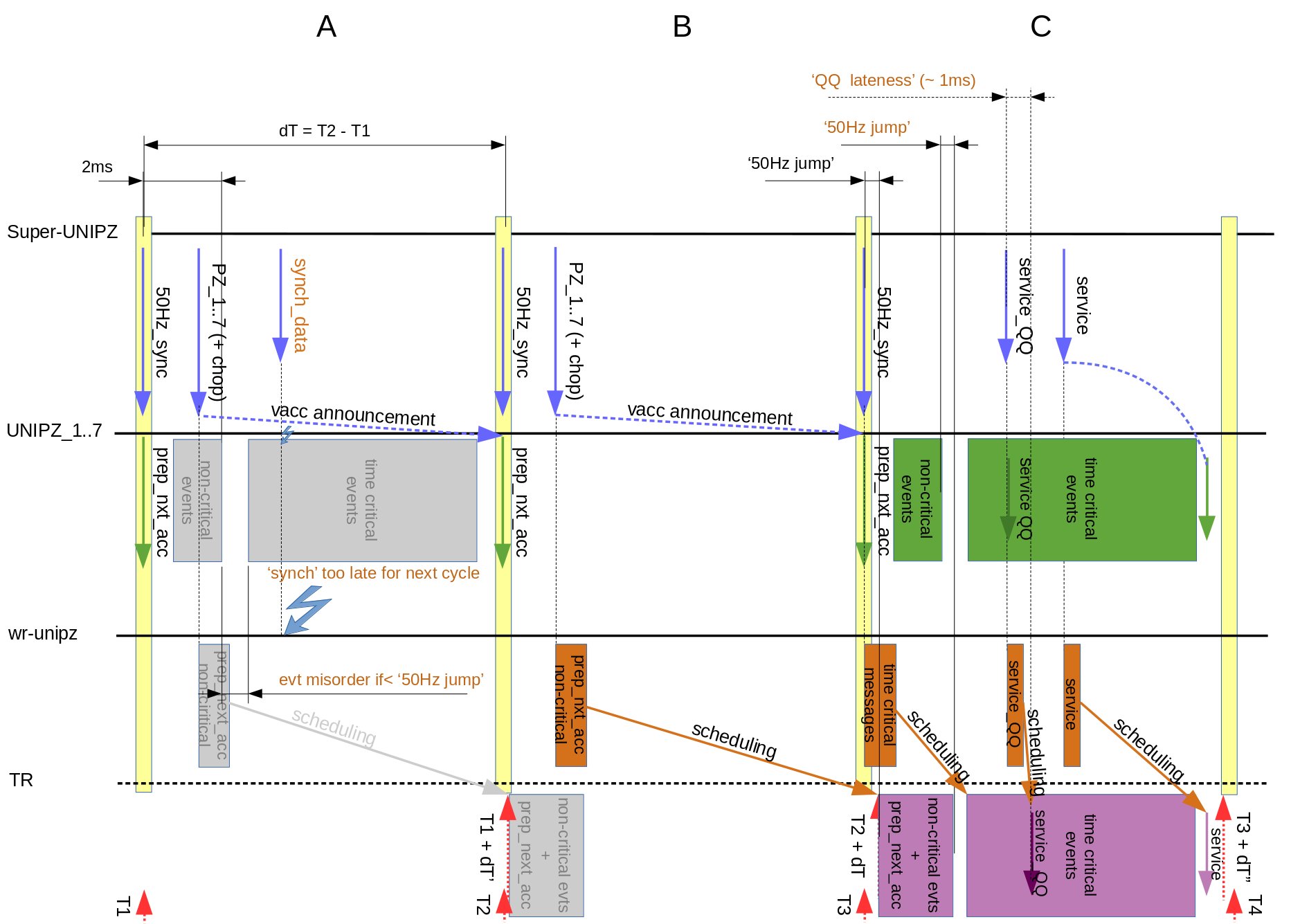 Figure:
Figure: Potential coneptual problems. Caveats are indicated by orange text. Grey boxes indicated activity in the othe cycles A and B. Explanation see text.
50 Hz Jump (black text)
The 50 Hz synchronisation has the task of following the 50 Hz mains frequency. Thus, UNILAC cycles vary in length. This is indacted by the '50 Hz jump' in the figure above. The hampers the prediction for T3 as the model for prediction assumes constant length. This has the following consequences
- 'prep_nxt_acc' and non-critical events in White Rabbit based timing will have an offset to the MIL events sent by the seven PZ 1..7
- the time difference between the last non-critical and the first time critical event differs from the original schedule and is not exactly predictable
This is not a principle problem but must be kept in mind when checking coincidene between timing events between White Rabbit timing and MIL timing (otherwise this
will drive you crazy).
Event Misorder due to 50 Hz Jump (orange text)
The model assumes that timing events at UNILAC are well separated. As a strict requirement, the time difference between the last non-critical and the first time-critical event
shall be larger than the '50 Hz jump'. If not, the order of events is jeopardized.
At present it is assumed that all events < 2ms after the start of cycle are non time critical.
Magnitude of 50 Hz Jump
According to Ralph, the magnitude of the 50 Hz jump should be in the order of 1 us. The present (February 2019) firmware does simple diagnostics. Amongst other values, it records the maximum and minimum value of the '50 Hz jump'. After about 10 days of operation in the test setup (Programmentwicklungsraum) the values
- min: -109 us
- max: +140 us
have been recorded. This might be smaller in the production system. Still, this is a potential issue. See section
measurements below.
Remark: Based on the observation above, the prediction algorithm has been changed and is now based on the average of the past 4 cycles.
Fire and Forget - Issue with Skipped 50 Hz Cycles.
wr-unipz begins scheduling timing messages ('prep_nxt_acc' and non-critical) for the relevant PZ 1..7 as soon as the corresponding event 'PZ_1..7' has been received from SPZ. This means, that event 'PZ_1..7' are a point of no return and all decisions for cycle C must have been taken as soon as the event has been received from SPZ (with exception of the service events).
However, the 50 Hz trigger module FX 202.021 measures the interval between consecutive 50 Hz triggers, which must be larger than 19.8 ms (see
doc, section 'Der 50 Hz-Generator'. In case the value is smaller than 19.8 ms, UNIPZ skips the following 50 Hz cycle and the already announced virtual accelerator will be executed one 50 Hz cycle later.
This leads to the potential issue for timing events that are played based on the prediction from previous cycles. In the White Rabbit based timing system, these events will be scheduled about 20 ms earlier compared to the MIL based UNIPZ.
Potential 'Synch Data' Issue
A 'synch_data' event from SPZ activates inactive schedules in shadow registers. This is a potential problem, if the 'synch_data' event happens
after the 'PZ1..7' events, as wr-unipz is an alarm based system and the Timing Receivers have already received the timing messages for the next cycle. Thus, if SPZ commits a virtual accelerator ('synch_data') in cycle A and schedules the same virtual accelerator already in cycle B, cycle B is messed up: It contains
old 'prep_nxt_acc' and non-critical events but
new time-critical events at the same time.
'QQ and A4 Lateness'
SPZ expects immediate execution of a service events for the QQ cavity and the Alvarez A4 section. But as White Rabbit provides an alarm based system, this is impossible. There are two options.
- wr-unipz schedules the timing message as soon as the service event is received. As a consequence it will be processed by the TRs ECA as quickly as possible. But there will be
- an unknown delay < 1ms
- the timing event at the front-end will be 'late' thus triggering an error condition
- wr-unipz schedules the timing message as soon as possible, but without causing a 'late event'. Then, there will be
- a known offset = 500us
- no error at the TR
As a fist solution, wr-unipz schedules the execution of these service events with an additional offset of 500us.
A More Complete View
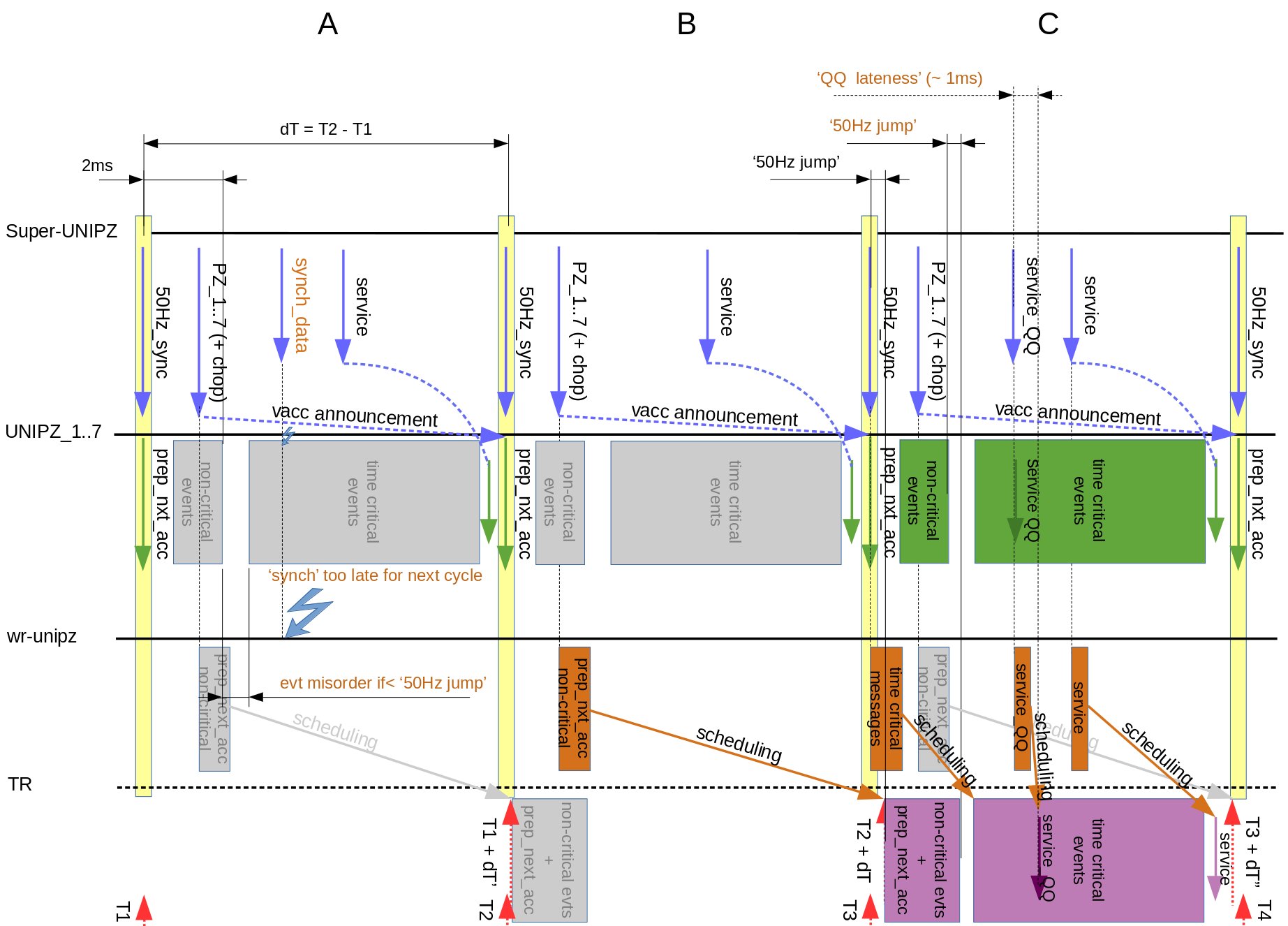 Figure:
Figure: A more complete view (but still not complet).
The figure above shows a more complete view, especially in cycle C. Gray boxes and arrows indicate part of other activity going on. Please note that the 'synch_data' activity shown in cycle A could also happen in cycle B or C. But I tried to avoid that complexity in that figure.
Proof-of-Pinciple Implementation
Status
A simple White Rabbit based timing system for UNILAC has been setup in 'Programmenttwicklungsraum'. It consists of the following:
- a White Rabbit switch
- an SCU as Data Master
- another SCU as TR lisening to UNILAC event on White Rabbit
With respect to the figures above, the firmware is implemented and feature complete and implements PZ1..7. There is a simple control program on the host system which allows to control and monitor vital properties.
A real schedule has been extracted from UNIPZ using a python script and written to a file. The schedule can be loaded to the firmware which listens to the internal MIL event bus.
Timing Messages are sent to the White Rabbit network and received via an SCU where they can be checked using the 'saft-ctl' CLI. A quick manual comparison to the original event tables of UNIPZ shows agreement, considering the '50 Hz jump' shifts all events within the first 2ms by a few us (compared to the events > 2ms).
Mapping
To get started, the following mapping from UNILAC properties to a timing message has been used.
| UNILAC Property |
Timing Message |
Value |
Remark |
| N/A |
FID |
same as GSI/FAIR |
|
| PZ 1..7 |
GID |
448..454 |
|
| evt number |
EvtNo |
ident |
| N/A |
flags |
|
don't use |
| virt acc |
SID |
ident |
| N/A |
BPID |
|
don't use |
| N/A |
reserved |
|
don't use |
| N/A |
request no beam |
|
don't use |
| N/A |
virt acc |
|
already in SID |
| flags Super PZ |
parameter field (hi bits) |
ident |
bits no chopper (0x1), short chopper (0x2) |
| event data |
parameter field (lo bits) |
ident |
bits rigid/hoch B_rho (0x2), dry (0x4), high current (0x8) |
Table: Conversion of UNILAC properties to White Rabbit timing.
This mapping should be subject to a CCT & Hanno decision. However, it is very charming as it allows to use present tools for development without modification.
Measurements
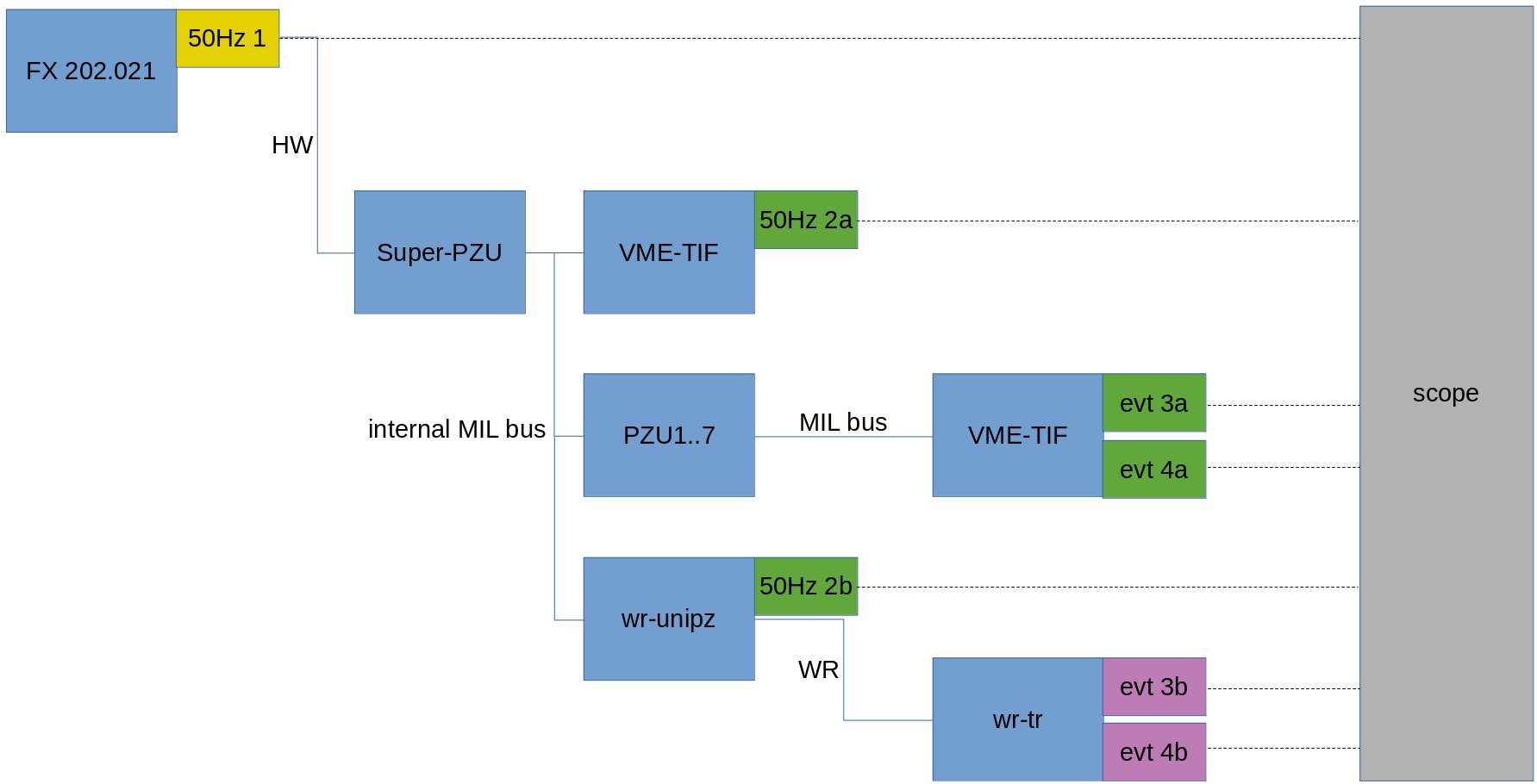 Figure:
Figure: Measurement setup. Color codes: hardware boxes (blue), outputs of 50 Hz synch unit (yellow), VME-TIFs (green) and WR (pink) and an oscilloscope (gray). HW boxes: FX 202.021 (50 Hz trigger unit synched to mains frequency), PZU ('Steuereineiten', SE), VME-TIF (MIL decoder in VME form factor), White Rabbit enabled hardware 'wr-...' (SCU). See text for details.
In the following measurements at the test system (Programmentwicklungsraum) are presented. For comparison, the timing section 'Alvarez' (PZU6) has been used.
Prediction of UNILAC Cycle Length
DEV
Statistics of the period of UNILAC cycle lengths has been measured using a scope connected to output '50 Hz 1' (FX 202.021) and '50 Hz 2a' (VME TIF).
Table: Variation of UNILAC cycle length and standard deviation. Data are taken within a few seconds (but not simultaneously). Details see text.
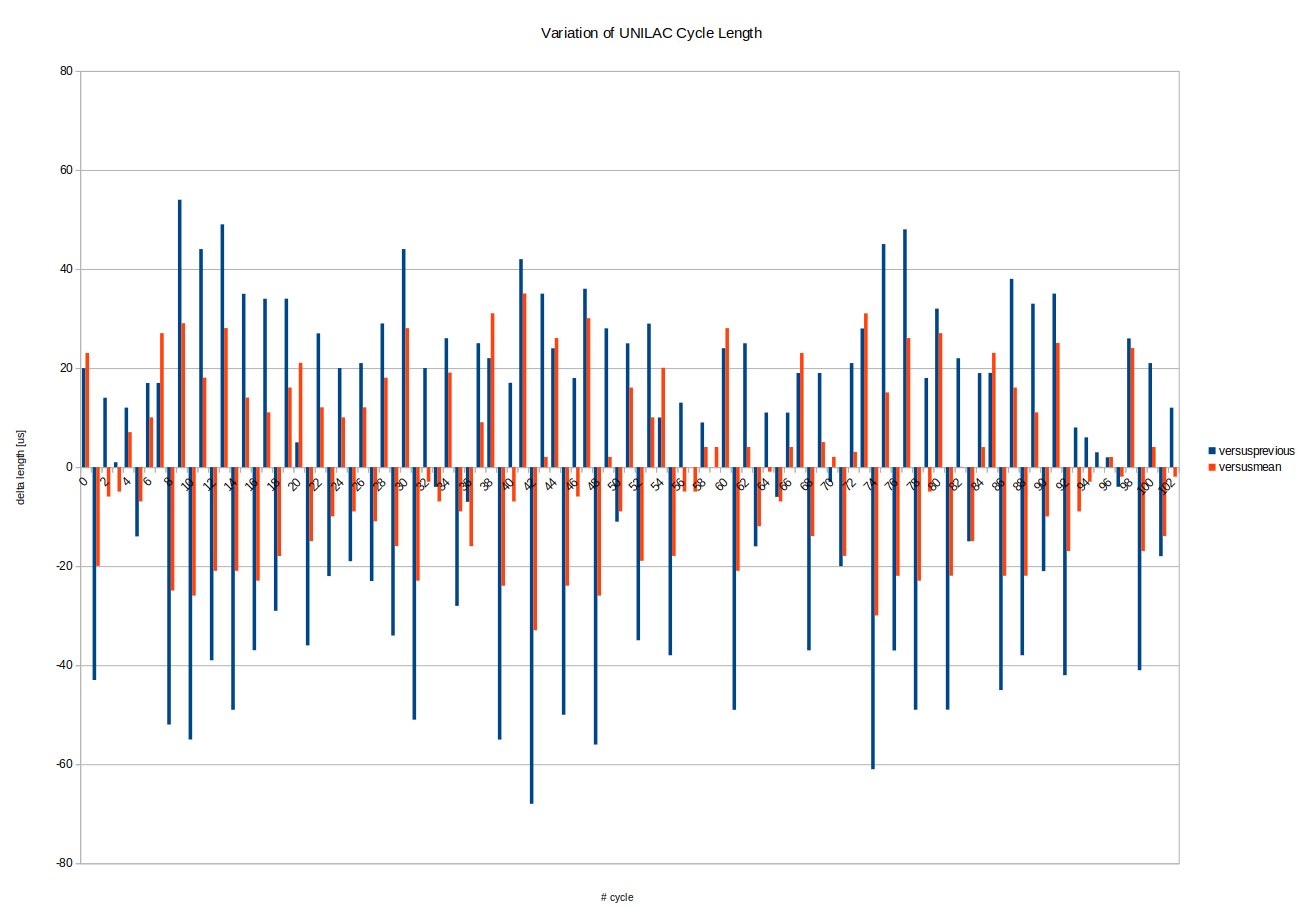 Figure:
Figure: Variation of cycle length as function of cycle number (DEV). Red: Difference from the average cycle length. Blue: Difference between two consecutive cycles. Details see text.
Mean values of UNILAC cycle length variation are shown in the table above. As can be seen, the variation happens in a window of about 100us.
The figure above show individually recorded values based on the '50HZ-sync' event on the internal MIL bus. While the deviations of individual cycles from the mean value shown in red is 'small' it is interesting to note, that a positive deviation is frequently followed by a negative deviation in the next cycle (and vice versa). This might be due to a control loop mainly based on a differential algorithm. This leads to even higher cycle-to-cycle variation shown in blue. Unfortunately, this increases the uncertainty when predicting the start of the next UNILAC cycle (which is important for wr-unipz!).
As first counter-measure, wr-unipz predicts the start of previous cycles not only on the past, but on the average of the past four cycles. The variation of the prediction is in the same order as for the hardware signals, but slightly increased.
To conclude, UNILAC cycle-to-cycle length variation of up to 100 us is common feature and thus limits the predictive power.
As a consequence the timing precision of all events within the first 2 ms of wr-unipz ist limited to about 50-100 us. However, the situation is different in the production system (see below).
PRO
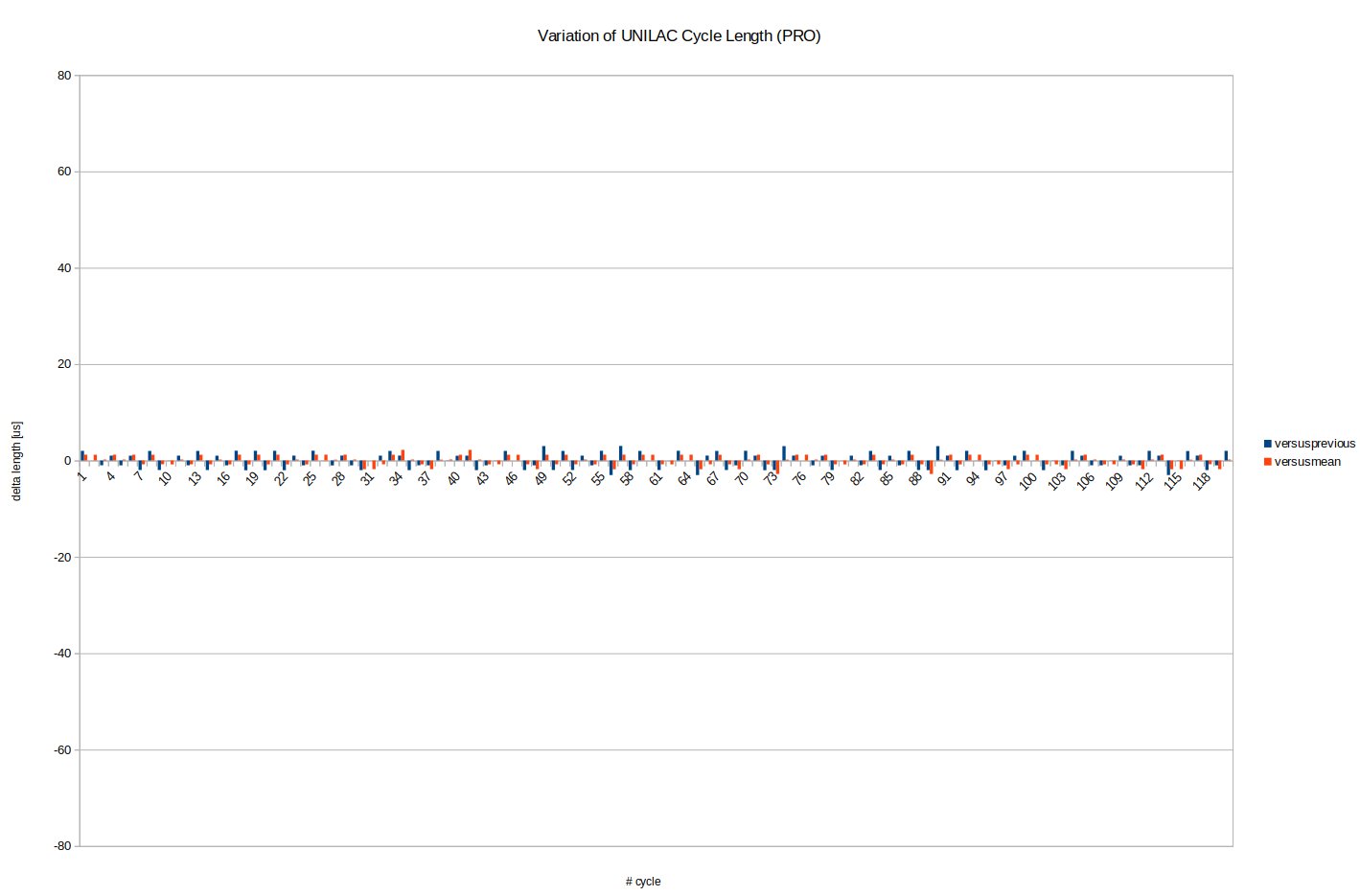 Figure:
Figure: Variation of cycle length as function of cycle number (PRO). Red: Difference from the average cycle length. Blue: Difference between two consecutive cycles.
As shown in the figure above, observed variations in cycle length in the production system (PRO) are much smaller than the ones observed in the developement system (DEV, see previos paragraph).
Precision of Timing System
| Measurement |
Signal I |
Signal II |
Offset [us] |
Min [us] |
Max [us] |
Window [us] |
sdev [us] |
Comment |
| A |
50 Hz 1 (HW) |
50 Hz 2a (MIL) |
+30.02 |
+29.49 |
+30.56 |
2.07 |
0.291 |
|
| B |
50 Hz 2a (MIL) |
50 Hz 2b (MIL) |
-2.30 |
-2.38 |
-2.28 |
0.10 |
0.024 |
(note the negative number) |
| C |
50 Hz 2a (MIL) |
evt 3a (MIL) |
+28.03 |
+27.06 |
+28.94 |
1.88 |
0.402 |
EVT_PREP_NEXT_ACC (note the non-zero offset) |
| D |
50 Hz 2a (MIL) |
evt 3b (WR) |
+25.80 |
-21.30 |
+73.20 |
94.50 |
19.960 |
EVT_PREP_NEXT_ACC (based on prediction of only one preceeding cycle) |
| E |
50 Hz 2a (MIL) |
evt 4a (MIL) |
+13264.305 |
+13262.878 |
+13265.598 |
2.720 |
0.478 |
EVT_BEAM_ON |
| F |
50 Hz 2a (MIL) |
evt 4b (WR) |
+13264.365 |
+13264.316 |
+13264.418 |
0.102 |
0.024 |
EVT_BEAM_ON |
| G |
evt 4b (WR) |
evt 4a (MIL) |
-0.065 |
-1.43 |
+1.23 |
2.67 |
0.470 |
EVT_BEAM_ON |
Table: Statistics of 'Signal I' compared to 'Signal II' measured using an oscilloscope. Details see text.
Measurements A
The Super-PZ is connected to the FX 202.021 hardware modules and distributes '50 Hz Sync' Events on the internal MIL bus. These events indicate the start of a UNILAC cycle. A VME TIF is connected to that internal bus.
- the '50 Hz sync' event is decoded ~30us later than the hardware pulse
- Super-PZ follows the signals from FX 202.021 closely and precisely
- window width ~2us
Measurements B
This is basically the same measurement as A, but taking the signal from the VME TIF at the internal bus as reference and using a MIL piggy on an SCU as TIF
- the MIL piggy decodes the signal ~2.3 us earlier than the VME TIF
- window width 100ns
Measurements C and D
Again the VME TIF on internal bus as reference. Here, the event EVT_PREP_NXT_ACC is used. This event is played at the beginning of each cycle. Thus, the timing of the WR system is limited by the predictive power of the UNILAC cycle, leading to a lousy precision of the events from the WR system.
- VME TIF in 'Alvarez' section
- MIL transport and decoding takes ~28us
- window width ~1.9us
- WR Timing Receiver
- huge window width of ~100us
- (this is due the limited predictive power of UNILAC cycle length)
Measurements E and F
Again the VME TIF on internal bus as reference. Here, the EVT_BEAM_ON is used which is late in the cycle. Thus, the precision of the WR system is based on precise timestamping of the 50 Hz events.
- VME TIF in 'Alvarez' section
- WR Timing Receiver
Measurement G
Here the EVT_BEAM_ON of the WR and MIL system are directly compared to each other. The result is consistent with the one of measurements E and F.
Conclusion
- in DEV, strong fluctuation of about 100 us are observed in the UNILAC cycle-to-cycle length
- in PRO, the observed fluctuations are significantly smaller
- precision
- events at the beginning of a cycle (< 2ms): WR @ UNILAC is hampered by the limited predictive power of the UNILAC cycle length. It is assumed that precise timing is not required early in a UNILAC cycle: Maybe this is ok.
- events later in the cycle (> 2ms): here the precision of the WR system seems to be more than an order of magnitude better than of the MIL timing system
Bits and Bites
PZ Numbers and Nomen
| # |
Nomen |
Type |
Name |
Abbreviate |
Description |
| 1 |
GUR_ZZ |
MIL |
Quelle Rechts (Nord) |
QR |
Source feeding into HSI |
| 1 |
GUR_ZD |
WR |
Quelle Rechts (Nord) |
QR |
Source feeding into HSI |
| 2 |
GUL_ZZ |
MIL |
Quelle Links ( Süd ) |
QL |
Source feeding into HSI |
| 2 |
GUL_ZD |
WR |
Quelle Links ( Süd ) |
QL |
Source feeding into HSI |
| 3 |
GUN2ZZ |
MIL |
Quelle HLI |
QN |
Source feeding into HLI |
| 3 |
GUN2ZD |
WR |
Quelle HLI |
QN |
Source feeding into HLI |
| 4 |
GUN_ZZ |
MIL |
Hochladungsinjektor |
HLI |
one injector bevore Alvarez |
| 4 |
GUN_ZD |
WR |
Hochladungsinjektor |
HLI |
one injector bevore Alvarez |
| 5 |
GUH_ZZ |
MIL |
Hochstrominjektor |
HSI |
another injector bevore Alvarez |
| 5 |
GUH_ZD |
WR |
Hochstrominjektor |
HSI |
another injector bevore Alvarez |
| 6 |
GUA_ZZ |
MIL |
Alvarez (tanks) |
AT |
Alvarez |
| 6 |
GUA_ZD |
WR |
Alvarez (tanks) |
AT |
Alvarez |
| 7 |
GTK_ZZ |
MIL |
Transferkanal |
TK |
transfer from UNILAC to SIS18 |
| 7 |
GTK_ZD |
WR |
Transferkanal |
TK |
transfer from UNILAC to SIS18 |
Table: List of timing sections of UNILAC.
Events UNIPZ Internal Bus
The Super-PZ sends events to the seven PZ1..7 on an internal MIL bus.
- bit 0..7: special event numbers, see below
- bit 8..15: meaning depends on event number, see below
| 0xEvtNo |
EvtName |
Description |
Format |
| 0x1..7 |
UNIPZ_EVT_PZ1..7 |
announce or service event; the event number designates the PZ |
see tables below |
| 0x32 |
UNIPZ_EVT_SYNCH_DATA |
commit event; a previously transferred event table becomes active |
see table below |
| 0x33 |
UNIPZ_EVT_50HZ_SYNCH |
50 Hz trigger; the next UNILAC cycle starts NOW |
see table below |
Table: List of event numbers used on the internal bus of UNIPZ
| Bits |
Value |
Description |
| 15 |
0 |
THIS is an announce event |
| 14 |
don't care |
short chopper pulse, presently unused; implemented via concept of 'Kanäle', see bit 12 |
| 13 |
0..1 |
no chopper pulse |
| 12 |
0..1 |
# of 'Kanal'; one bit is enough as we only have two 'Kanäle' |
| 8..11 |
0..15 |
# of virtual accelerator |
| 0..7 |
UNPZ_EVT_PZ1..7 |
# of 'Pulszentrale'; counting starts at '1' |
Table: Format of
announce events. This event type is used to announce what shall be played during the next cycle.
| Bits |
Value |
Description |
| 15 |
1 |
THIS is a service event |
| 12..14 |
111 (bits 12..15: 0xf) |
send service event EVT_MAGN_DOWN after the other events withing the same cycle |
| 12..14 |
110 (bits 12..15: 0xe) |
send service event EVT_AUX_PRP_NXT_ACC after the other events withing the same cycle |
| 12..14 |
101 (bits 12..15: 0xd) |
send service event EVT_AUX_PRP_NXT_ACC NOW (very special case for QQ @ 2019) |
| 12..14 |
100 (bits 12..15: 0xc) |
send service event EVT_UNLOCK_ALVAREZ NOW (very special case for A4 @ 2020) |
| 8..11 |
0..15 |
# of virtual accelerator |
| 0..7 |
UNPZ_EVT_PZ1..7 |
# of 'Pulszentrale'; counting starts at '1' |
Table: Format of
service events. This event type instructs the PZ to play a special additional event during a cycle.
Table: Format of
synch data events.
Table: Format of
50 Hz trigger events.
Events UNIPZ (User)
UNILAC uses event numbers in the range 0..255 (8 bit). Please have a look
here (evt no 0..255).
| Bits |
Value |
Description |
| 15 |
0..1 |
'high current', 'Hochstrom' - correction in rf-systems needed |
| 14 |
0..1 |
'dry' - UNILAC cycle runs without beam |
| 13 |
0..1 |
'Hoch-B_rho', 'rigid beam' - low charge state; set power supplies for high magnet current |
| 12 |
|
don't care |
| 8..11 |
0..15 |
# of virtual accelerator |
| 0..7 |
0..255 |
event number |
Table: Format of 'timing events'.
Beam info
The previous section mentions some bits that give information on the current beam.
| Info |
Provided via |
Source |
real-time |
Configured in Schedule |
Description |
| No Chopper |
Super PZ |
PZU Interlock |
x |
|
prevents opening of chopper [1] |
| Short Chopper |
Super PZ |
via PZU Interlock |
x |
|
length of chopper pulse is reduced [2] |
| (Operator selects 'Profilgitter') |
|
(x) |
implemented by switchig to a 2nd 'Kanal' that must be pre-configured by data supply |
| Hoch-B_rho |
Schedule |
Operator |
|
x |
rigid beam (info required for power supplies) |
| No-Beam |
Schedule |
Operator |
|
x |
UNILAC runs dry |
| High Current |
Schedule |
Operator |
|
x |
beam loading (info required for RF systems) |
Table: Some information on beam properties. I (db) am not 100% sure this is correct.
[1] Another source for 'no chopper' is probably the modulbus interface to SIS18 (dry-run-flag).
[2] The operator selects the 'Profilgitterschutz-Taster'. Via MIL bus, this is transmitted to the interlock unit. The interlock status is analyzed by the Super PZ prior to each cycle.
--
DietrichBeck - 18 Aug 2020
 Figure: Integration of White Rabbit Pulszentrale into UNILAC Pulszentrale. Shown are the existing components Settings Management (grey box), Super Pulszentrale (light green box), Pulszentralen 1..7 (green boxes) and the new White Rabbit Pulszentrale (blue box). As well shown are MIL event bus lines (green arrows), a White Rabbit network (blue arrows) as well as connections from Super Pulszentrale to PZs (black arrows). Details see text.
Today (2020) the UNILAC is still operated using the 'old GSI control system' Device Access . The timing system is based on a so-called MIL Event Bus with a Pulszentrale (PZ) as master. UNILAC has seven timing areas with one PZ each. Thus, there are seven distinct MIL cables, one for each PZ. The seven PZs are coordinated via the Super Pulszentrale (SPZ), which has two tasks.
Figure: Integration of White Rabbit Pulszentrale into UNILAC Pulszentrale. Shown are the existing components Settings Management (grey box), Super Pulszentrale (light green box), Pulszentralen 1..7 (green boxes) and the new White Rabbit Pulszentrale (blue box). As well shown are MIL event bus lines (green arrows), a White Rabbit network (blue arrows) as well as connections from Super Pulszentrale to PZs (black arrows). Details see text.
Today (2020) the UNILAC is still operated using the 'old GSI control system' Device Access . The timing system is based on a so-called MIL Event Bus with a Pulszentrale (PZ) as master. UNILAC has seven timing areas with one PZ each. Thus, there are seven distinct MIL cables, one for each PZ. The seven PZs are coordinated via the Super Pulszentrale (SPZ), which has two tasks.  Figure: Most simplified view on UNIPZ (upper part). It is a combination of a Super-UNIPZ and seven UNIPZ1..7. Shown are three UNILAC cycles A, B and C. Short red arrow: Beginning of a UNILAC cycle T1..T4. Blue arrows: MIL events from Super-UNIPZ. Green arrows and boxes: MIL events from UNIPZ1..7 to front-end computers. See text for more details.
The above figure shows a simple overview on UNIPZ. Each cycle has a length of approximately 20 ms (50 Hz). Cycles are synchronized to the 50 Hz mains frequency (not shown). A hardware logic follows the variation in the mains frequency slowly, thus UNILAC cycles may differ in length. In the figure above this is depicted as '50 Hz jump' (this will be important later).
UNIPZ consists of seven "Pulszentralen" PZ 1..7. Each is dedicated to a specific section in UNILAC and controls real-time activity in that section be sending so-called 'timing-events' over the 'MIL event bus'. The overall coordination of PZ 1..7 is controlled via the so-called 'Super PZ' (SPZ). For this, PZ 1..7 are connected to the SPZ via an internal MIL event bus and SPZ controls PZ 1..7 by sending events (over that internal bus).
PZ 1..7 get supplied with schedule data in a two-step process. First, schedule data is loaded 'offline' into shadow registers of PZ 1..7 (not shown). Second, schedule data in a shadow register is activated from SPZ by sending a 'synch_data' event to the relevant PZ.
Let's look at UNILAC cycle C in the above figure. As UNILAC supports up to 15 virtual accelerators and different settings for the beam chopper, this must be announced in the previous cycle B via an event 'PZ_1..7 (+ chop)' on the internal bus. Note, there is a separate event for each of the seven PZ 1..7. A UNILAC cycle is started, once SPZ sends a '50Hz_synch' event to the seven PZ 1..7; there is only one event for all PZs. This event is sent for each UNILAC cycle at a time indicated by short red arrows T1..4. Each of the seven PZ 1..7 immediately sends out an event 'prep_next_acc' to its section. Shortly after beginning of cycle C, the events are not time-critical and call for preparation of things happening in this cycle (left green box). Events later in the cycle are time-critical to about 1us (right green box).
While a cycle is running, SPZ may send 'service events' to one or more of PZ 1..7. Such service events will be played after the schedule in a PZ has been played. An exception is a service event for the so-called QQ cavity, which must be sent out immediately. There is only one service event per cycle and PZ (but I am not sure if a 'QQ service event' may be played additionally)
Figure: Most simplified view on UNIPZ (upper part). It is a combination of a Super-UNIPZ and seven UNIPZ1..7. Shown are three UNILAC cycles A, B and C. Short red arrow: Beginning of a UNILAC cycle T1..T4. Blue arrows: MIL events from Super-UNIPZ. Green arrows and boxes: MIL events from UNIPZ1..7 to front-end computers. See text for more details.
The above figure shows a simple overview on UNIPZ. Each cycle has a length of approximately 20 ms (50 Hz). Cycles are synchronized to the 50 Hz mains frequency (not shown). A hardware logic follows the variation in the mains frequency slowly, thus UNILAC cycles may differ in length. In the figure above this is depicted as '50 Hz jump' (this will be important later).
UNIPZ consists of seven "Pulszentralen" PZ 1..7. Each is dedicated to a specific section in UNILAC and controls real-time activity in that section be sending so-called 'timing-events' over the 'MIL event bus'. The overall coordination of PZ 1..7 is controlled via the so-called 'Super PZ' (SPZ). For this, PZ 1..7 are connected to the SPZ via an internal MIL event bus and SPZ controls PZ 1..7 by sending events (over that internal bus).
PZ 1..7 get supplied with schedule data in a two-step process. First, schedule data is loaded 'offline' into shadow registers of PZ 1..7 (not shown). Second, schedule data in a shadow register is activated from SPZ by sending a 'synch_data' event to the relevant PZ.
Let's look at UNILAC cycle C in the above figure. As UNILAC supports up to 15 virtual accelerators and different settings for the beam chopper, this must be announced in the previous cycle B via an event 'PZ_1..7 (+ chop)' on the internal bus. Note, there is a separate event for each of the seven PZ 1..7. A UNILAC cycle is started, once SPZ sends a '50Hz_synch' event to the seven PZ 1..7; there is only one event for all PZs. This event is sent for each UNILAC cycle at a time indicated by short red arrows T1..4. Each of the seven PZ 1..7 immediately sends out an event 'prep_next_acc' to its section. Shortly after beginning of cycle C, the events are not time-critical and call for preparation of things happening in this cycle (left green box). Events later in the cycle are time-critical to about 1us (right green box).
While a cycle is running, SPZ may send 'service events' to one or more of PZ 1..7. Such service events will be played after the schedule in a PZ has been played. An exception is a service event for the so-called QQ cavity, which must be sent out immediately. There is only one service event per cycle and PZ (but I am not sure if a 'QQ service event' may be played additionally)
 Figure: Concept of wr-unipz (lower part). Dark orange boxes indicate when wr-unipz sends timing messages to the White Rabbit network. Dark orange arrows indicate how far in the future wr-unipz schedules actions. Pink arrows and boxes: Actions triggered by 'timing events'. See text for more details.
Let's assume the length dT of UNILAC cycles is unknown but constant over the three cycles A, B and C. In a time based system it is easy to timestamp T1 and T2. Then the time of the start of cycle C can be predicted
T3 = T2 + dT.
Now, wr-unipz is able to schedule the event 'prep_nxt_acc' and the non-critical events as soon as the SPZ sends the events 'PZ_1..7' via the internal event bus. This happens already in cycle B (left orange box). The remaining time critical events are sent once the event '50Hz_synch' is received from SPZ (right orange box). When wr-unipz schedules, it broadcasts timing messages via the White Rabbit network. The messages are received by the Timing Receivers (TR), where the messages are filtered and forwarded to ECA channels and stored. On-time, the TR generates timing events (pink boxes). For a description off the ECA, see here and article.
Scheduling of service events by wr-unipz is also straight forward as the length of the schedule received from SPZ is known. Only the 'QQ service event' suffers a small delay (see below).
Figure: Concept of wr-unipz (lower part). Dark orange boxes indicate when wr-unipz sends timing messages to the White Rabbit network. Dark orange arrows indicate how far in the future wr-unipz schedules actions. Pink arrows and boxes: Actions triggered by 'timing events'. See text for more details.
Let's assume the length dT of UNILAC cycles is unknown but constant over the three cycles A, B and C. In a time based system it is easy to timestamp T1 and T2. Then the time of the start of cycle C can be predicted
T3 = T2 + dT.
Now, wr-unipz is able to schedule the event 'prep_nxt_acc' and the non-critical events as soon as the SPZ sends the events 'PZ_1..7' via the internal event bus. This happens already in cycle B (left orange box). The remaining time critical events are sent once the event '50Hz_synch' is received from SPZ (right orange box). When wr-unipz schedules, it broadcasts timing messages via the White Rabbit network. The messages are received by the Timing Receivers (TR), where the messages are filtered and forwarded to ECA channels and stored. On-time, the TR generates timing events (pink boxes). For a description off the ECA, see here and article.
Scheduling of service events by wr-unipz is also straight forward as the length of the schedule received from SPZ is known. Only the 'QQ service event' suffers a small delay (see below).
 Figure: Potential coneptual problems. Caveats are indicated by orange text. Grey boxes indicated activity in the othe cycles A and B. Explanation see text.
Figure: Potential coneptual problems. Caveats are indicated by orange text. Grey boxes indicated activity in the othe cycles A and B. Explanation see text.
 Figure: A more complete view (but still not complet).
The figure above shows a more complete view, especially in cycle C. Gray boxes and arrows indicate part of other activity going on. Please note that the 'synch_data' activity shown in cycle A could also happen in cycle B or C. But I tried to avoid that complexity in that figure.
Figure: A more complete view (but still not complet).
The figure above shows a more complete view, especially in cycle C. Gray boxes and arrows indicate part of other activity going on. Please note that the 'synch_data' activity shown in cycle A could also happen in cycle B or C. But I tried to avoid that complexity in that figure.
 Figure: Measurement setup. Color codes: hardware boxes (blue), outputs of 50 Hz synch unit (yellow), VME-TIFs (green) and WR (pink) and an oscilloscope (gray). HW boxes: FX 202.021 (50 Hz trigger unit synched to mains frequency), PZU ('Steuereineiten', SE), VME-TIF (MIL decoder in VME form factor), White Rabbit enabled hardware 'wr-...' (SCU). See text for details.
In the following measurements at the test system (Programmentwicklungsraum) are presented. For comparison, the timing section 'Alvarez' (PZU6) has been used.
Figure: Measurement setup. Color codes: hardware boxes (blue), outputs of 50 Hz synch unit (yellow), VME-TIFs (green) and WR (pink) and an oscilloscope (gray). HW boxes: FX 202.021 (50 Hz trigger unit synched to mains frequency), PZU ('Steuereineiten', SE), VME-TIF (MIL decoder in VME form factor), White Rabbit enabled hardware 'wr-...' (SCU). See text for details.
In the following measurements at the test system (Programmentwicklungsraum) are presented. For comparison, the timing section 'Alvarez' (PZU6) has been used.
 Figure: Variation of cycle length as function of cycle number (DEV). Red: Difference from the average cycle length. Blue: Difference between two consecutive cycles. Details see text.
Mean values of UNILAC cycle length variation are shown in the table above. As can be seen, the variation happens in a window of about 100us.
The figure above show individually recorded values based on the '50HZ-sync' event on the internal MIL bus. While the deviations of individual cycles from the mean value shown in red is 'small' it is interesting to note, that a positive deviation is frequently followed by a negative deviation in the next cycle (and vice versa). This might be due to a control loop mainly based on a differential algorithm. This leads to even higher cycle-to-cycle variation shown in blue. Unfortunately, this increases the uncertainty when predicting the start of the next UNILAC cycle (which is important for wr-unipz!).
As first counter-measure, wr-unipz predicts the start of previous cycles not only on the past, but on the average of the past four cycles. The variation of the prediction is in the same order as for the hardware signals, but slightly increased.
To conclude, UNILAC cycle-to-cycle length variation of up to 100 us is common feature and thus limits the predictive power. As a consequence the timing precision of all events within the first 2 ms of wr-unipz ist limited to about 50-100 us. However, the situation is different in the production system (see below).
PRO
Figure: Variation of cycle length as function of cycle number (DEV). Red: Difference from the average cycle length. Blue: Difference between two consecutive cycles. Details see text.
Mean values of UNILAC cycle length variation are shown in the table above. As can be seen, the variation happens in a window of about 100us.
The figure above show individually recorded values based on the '50HZ-sync' event on the internal MIL bus. While the deviations of individual cycles from the mean value shown in red is 'small' it is interesting to note, that a positive deviation is frequently followed by a negative deviation in the next cycle (and vice versa). This might be due to a control loop mainly based on a differential algorithm. This leads to even higher cycle-to-cycle variation shown in blue. Unfortunately, this increases the uncertainty when predicting the start of the next UNILAC cycle (which is important for wr-unipz!).
As first counter-measure, wr-unipz predicts the start of previous cycles not only on the past, but on the average of the past four cycles. The variation of the prediction is in the same order as for the hardware signals, but slightly increased.
To conclude, UNILAC cycle-to-cycle length variation of up to 100 us is common feature and thus limits the predictive power. As a consequence the timing precision of all events within the first 2 ms of wr-unipz ist limited to about 50-100 us. However, the situation is different in the production system (see below).
PRO
 Figure: Variation of cycle length as function of cycle number (PRO). Red: Difference from the average cycle length. Blue: Difference between two consecutive cycles.
As shown in the figure above, observed variations in cycle length in the production system (PRO) are much smaller than the ones observed in the developement system (DEV, see previos paragraph).
Figure: Variation of cycle length as function of cycle number (PRO). Red: Difference from the average cycle length. Blue: Difference between two consecutive cycles.
As shown in the figure above, observed variations in cycle length in the production system (PRO) are much smaller than the ones observed in the developement system (DEV, see previos paragraph).
 Copyright © by the contributing authors. All material on this collaboration platform is the property of the contributing authors.
Copyright © by the contributing authors. All material on this collaboration platform is the property of the contributing authors. 

